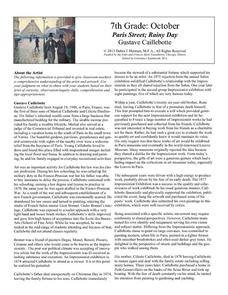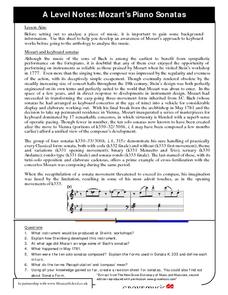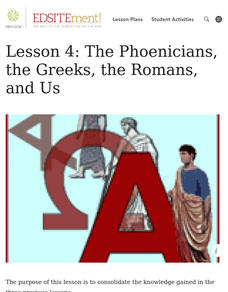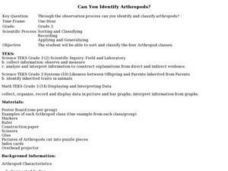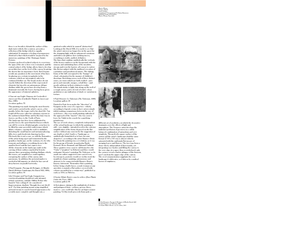Curated OER
Lesson: Younger Than Jesus: Understanding, Looking at, Making Abstract Art
Before the class makes abstract art, they see contemporary examples and analyze them. They look at art made by abstract artists under the age of 33 then use similar techniques to create an interesting collection of their own. The lesson...
Curated OER
Families and Heredity
Personality traits and physical appearance traits within families are the focus here. Learners make a poster which lists the shared physical traits they have with their family. Peers look at each poster and write down the traits they see...
Curated OER
Nureyev: After Petipa
Incorporating the arts into regular classroom practices isn't an easy task. Learners will research background information regarding Russian culture, history, and conflict then see how those things have applied to the rigors of Russian...
Curated OER
Printmaking
Analyze the process of printmaking and explore how prints reflect an artist's view of society. After viewing and analyzing the prints of Elizabeth Catlett, class members create an inner tube and a linoleum block print. They then research...
Concordia University Chicago
Paris Street; Rainy Day by Gustave Caillebotte
Discuss the balance, color, emotion, and context of the painting Paris Street; Rainy Day by Caillebotte. After a deep discussion, let creativity run free in your class as learners create a dimensional piece that reflects a...
Curated OER
Where Are the Dinosaurs?
Students explore the concept of extinction by studying dinosaurs. In this dinosaur lesson, students distinguish between extinct creatures and those that still exist.
Curated OER
The Alphabet is Historic: The Roman Alphabet is our Alphabet
Pupils show that the Greeks, Phoenicians and Romans lived in the Mediterranean area. They give reasons why the alphabet was important for the Romans. and say that the Romans developed the alphabet they are learning in school.
Curated OER
Where are the Dinosaurs?
Young scholars construct their own diorama based on the life of a dinosaur. In this dinosaur lesson, students create models of dinosaurs and dinosaurs' eggs to explore the life cycle of this extinct species.
Curated OER
Mozart's Piano Sonatas
In this music worksheet, students examine the work of Mozart while focusing upon his works of piano sonatas. They answer the questions at the end of the passage.
Curated OER
Portraits in the Birmingham Museum and Art Gallery
In this art gallery set of worksheets, students examine a set of portraits that are located in the Birmingham Museum and Art Gallery. They answer a set of questions about each piece of art which is pictured on the worksheets.
Curated OER
Money Vocabulary
In this money worksheet, students look at 5 pictures and name each one, walk around the room find somebody that fits 6 scenarios and match 10 verbs in bold print with their appropriate phrases in grey.
Curated OER
School Redesign and Multiple Intelligences
Students examine their own intelligence to find areas of strength after studying the multiple intelligences. In this diverse learning styles lesson plan, students analyze how the school environment fosters or fails students of...
National Endowment for the Humanities
Lesson 4: The Phoenicians, the Greeks, the Romans, and Us
Learners review knowledge gained in the three-part unit on the history of the alphabet. Using maps and images, learners consolidate their understanding of ancient Greece, the Romans and the Phoenicians, and their respective impacts...
Curated OER
Albinistic Animals Are Awesome
Are all academicians allured with alliteration? Use this cross-curricular online resource to simultaneously expose your scholars to parts of speech and the genetic mutation causing albinism. Initial context gives students an introduction...
Curated OER
Peanut Butter Broccoli
Fifth graders explore food production by viewing DNA presentations. In this genetic engineering lesson, 5th graders discuss the foods they typically eat at home and how many common foods are engineered in a way that can produce a bigger...
Curated OER
Can You Identify Arthropods?
Third graders sort and classify the four Arthropod classes. They are given puzzle pieces of one Arthropod example. Each group is to put their puzzle together, glue it on a piece of construction paper and label the ir puzzle.
Curated OER
Bringing Up Birdy
Students explore biology by creating diagrams of animal life cycles. In this baby bird activity, students view video clips of birds being born from incubation to flying on their own. Students utilize the Internet to research birds and...
Curated OER
Personality Collage
Learners trace their profile on their poster board by projecting their shadow onto the poster board. OR students may lie on the ground on a very large piece of paper and trace around themselves with a pencil.
Curated OER
Can I Feel Your Pain? A Sculpture Project
Students conduct research dealing with some aspect of human rights in Latin America. They create a sculpture as a response to an instance of repression that touched them from their research. They give a brief oral report on their country.
Curated OER
Culture in Art
High schoolers explore how cultural aspects of their lives are depicted in society. They view a video on Frida Kahlo and identify the cultural elements that she referenced in her work.
Curated OER
What's Your Brand?
Students explore the history of branding livestock and discover it began as early as 2000 BC. They discuss reasons for branding and then design their own brand from pipe cleaners. Students dip their brand into paint and print it on...
Curated OER
Square Dancing
Fourth graders investigate the concept of using punnett squares in the determination of the offspring.They collect drawings and pictures and create a collection for student science journals.
Curated OER
My Ideal World
Students create an image symbolic of their ideal world. In this lesson inspired by To Kill a Mockingbird and the artwork of Edward Hicks, students use Adobe Photoshop to create an image symbolic of their personal utopia.
Curated OER
The Rise of Landscape Painting
Students study the rise of landscape art throughout the 19th century and the specific features of the genre. In this landscape art activity, students read the definition of landscape art and its precedence in the 19th century. Students...
Other popular searches
- Genetic Inheritance
- Polygenic Inheritance
- Chromosomes and Inheritance
- Mendelian Inheritance
- Human Inheritance
- Inheritance Patterns
- Color Blindness Inheritance
- Variation and Inheritance
- Sex Linked Inheritance
- Inheritance of Blood Types
- Basic Inheritance Patterns
- Genetic Inheritance Quiz




